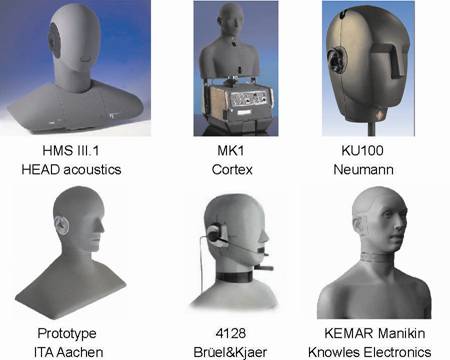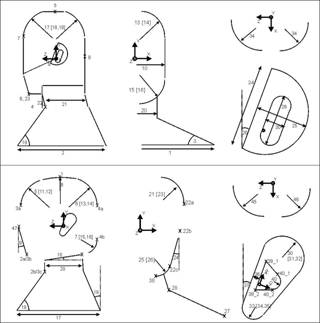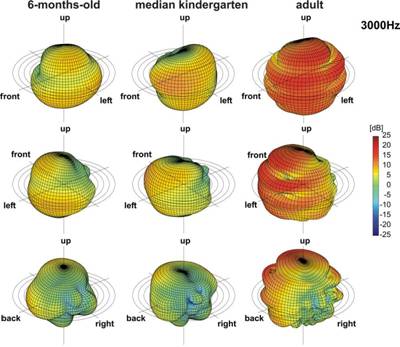


The Next Generation of Artificial Heads
Janina Fels, Janina.Fels@akustik.rwth-aachen.de, and
Michael Vorländer, mvo@akustik.rwth-aachen.de
Institute of Technical Acoustics
RWTH Aachen University, Neustr. 50, 52066 Aachen, Germany
Popular version of paper 2aPPa4
"The next generation of artificial heads"
Presented 9:00 a.m. on Tuesday July 1, 2008
Introduction
Hearing is one of the most important senses of human beings. Hearing, however, does not only refer to our ability to perceive voices and sounds. Our two ears make it also possible to have a spatial perception.
Hearing with both ears is thus referred to as binaural hearing. It enables us to hear sounds accurately and naturally. While hearing with two ears, we receive sounds from both, the left and the right ear, which makes it easier for us to locate the direction of sounds. Binaural hearing depends to a large degree on the geometrical parameters of the human body (especially torso, head, and ears).
An artificial head is a binaural stereo microphone. It resembles the human head and features two microphones which are built into the ears. If someone listens to a recording of an artificial head using headphones, he or she will be under the impression to be right at the scene of the acoustic event.
In recent years experts ventured into several new fields of application such as product sound-design, room acoustics or telecommunications. These applications were based on the geometry of the head described in an international standard, which was originally developed for hearing aid tests. It has been common knowledge for some time now, that on the one hand specific artificial heads for recordings are superior to standard artificial heads in terms of the quality of spatial hearing and that one the other hand the latter do not comply with the head dimensions of a mean population, as the standard heads turned out to be too small.
In this article the present situation is assessed. Based on this analysis a concept will be developed which is meant to lead the creation of a possible new international norm for artificial heads. This future norm should include an improved representation of an adult population. Moreover new approaches with artificial heads for children for applications such as measuring and fitting hearing aids or acoustic measurements in class rooms should be taken into account.
A Head-Related Transfer Function (HRTF) describes how a given sound wave input is filtered by the diffraction and reflection properties of the head, pinna, and torso, before the sound reaches the eardrum.
HRTF measurements of a population of US-American troops in the 1960s provided the basis for today’s knowledge of the measurement technology for artificial heads. In 1972 “KEMAR“[1] was finally introduced (see Fig. 1). “KEMAR” was at first used to carry out measurements with hearing aids under in-situ conditions.

Fig. 1 : Hearing aid development with the first artificial head “KEMAR” (courtesy of Siemens Hearing Solutions)
Afterwards it was used as a database for virtual acoustics and binaural technologies for Home-Video.
In the 1980s Genuit improved and developed at the IENT/RWTH, Aachen, together with his colleagues Blauert, Platte and Laws, technologies for artificial heads by introducing a parametric (geometrical) model and a reliable averaging of anatomical data [2]. This model was then used to calculate the noise diffraction at the head systematically. Many companies use this head and its follow-up models as well as other geometrically writeable heads for a variety of measurements (see Fig. 2).

Fig. 2 : Artificial Heads
These modern and nowadays widely-used artificial heads were studied in comparative tests, especially with regard to objective data such as HRTFs, headphones-transfer-functions or ear protection insulation. Applications such as hearing aid measurements are still of great interest while measurements of all kinds of telephones have also gained importance. Geometrically writeable heads offer an advantage: an easy traceability and standardization. Problems might, however, occur if one intends to listen to recordings with artificial heads or tries to carry out tests which are meant to analyze the spatial accuracy. These problems might occur due to the fact that HRTFs of individual human beings are rarely compatible. Artificial heads which were specifically designed for hearing tests, as copy, so to speak, of an ideal mean test subject, are superior in terms of the spatial representation. It is interesting to note that these specific heads are usually bigger (wider) than envisioned in the international standard. The anatomical data of human beings has apparently undergone changes since the 1960s. These current findings thus cast a doubt on the KEMAR database.
The question that arises now, is whether standard heads can be used for populations all over the world or whether it is even possible to use them to represent children and their anatomic dimensions or not. A study was thus carried out on a larger scale [3] which resulted in a standard procedure for the averaging of anatomical data. Moreover tests were carried out to determine the influence of the different anthropometric parameters on the spatial hearing.

Fig. 3 : Anthropometric Parameters for adults (top) and children (bottom)
In [3] HRTFs are obtained with the help of a simulation. Different approaches were taken to test this method. CAD-models for the head and torso were created und the HRTFs of these models were measured with the help of a standard technique. While comparing the results of the simulation and the measurement, it turned out that they were similar. Afterwards data concerning anthropometric parameters and the CAD-modeling were obtained. The database providing the anthropometric data (see Fig-3) required for this model includes so far data of 95 test subjects aged from six months to 18 years. Figures 4 and 5 show the differences as far as the HRTFs are concerned at these three stages of age. This database is an excellent starting point of the development for new artificial heads.

Fig. 4 : Head-related transfer functions of a six-months-old infant, median kindergarten, and adult head at a frequency of 3000 Hz, viewed from various angles

Fig. 5 : Head-related transfer functions of a six-months-old infant, median kindergarten, and adult head at a frequency of 3000 Hz, viewed from various angles
The compiled anthropometric data was statistically analyzed and an artificial head featuring median values was thus created. This head was used to evaluate the influence of every single parameter. One parameter was changed each time measurements were carried out, so that the influence of the different parameters could be analyzed (see animations in Figure 6). By comparing the HRTFs and other binaural parameters of these heads with those of the median head, the influence of the different parameters became clearer [3].
|
|
Fig. 6 : Animations of the parameter studies. Only one parameter was changed each time to investigate the influence on the binaural hearing.
This procedure made it possible to study the most important parameters defining the head. The results show that the following parameters have a big influence on the HRTFs and the binaural cues:
It is therefore crucial to determine these parameters as exact as possible while other parameters (chin, back vertex, head height) have far less influence. The influence of the pinna growth on the HRTF was studied in compliance with the different parameter variations and the torso geometry. The height of the head, the parameter that changes the most during growth, has the least influence on the HRTF and the binaural cues. The following parameters have got the biggest influence:
Having obtained these results, it is now possible to classify extensive parameter databases accordingly to identify a suitable data set (several data sets would be required for children).
Artificial heads have been used for whole range of applications for the last decades including audiology, room acoustics, acoustic product design and sound quality. In this context head-, torso- and pinna-structures are a vital factor for binaural recordings. In recent years questions surrounding the accuracy of the international norm have arisen . A crucial aspect is the fact that the anatomy of adults has undergone changes since the data for these standards has been compiled. Moreover these standardized artificial heads are not suitable for children as head, torso and pinna/ear canal change to a different extent while children are growing.
Based on an initiative of the NALS (Acoustics, Noise Control and Vibration Engineering Standards Committee) of the DIN (German Institute for Standardization) a scheme was presented on an international level which aims at creating a new norm for artificial heads for a „family“ of artificial heads. This approach should combine an extensive data acquisition, a statistical evaluation of a set of parameters, which remains to be determined. Moreover it should include a numerical calculation of the HRTF and all experts involved should agree on a limited number of geometries which could be divided into age groups and continents. Researchers in the field declared their support during a meeting of the project initiative in Madrid (during the ICA 2007). Further discussions will be taking place and concrete steps will be discussed during the Acoustics08 meeting which will be taking place in Paris at the end of June 2008. Researchers in the field of artificial heads, users as well as producers of artificial heads will participate in this conference. It will hopefully be possible to present the first results and proposals in the near future.
[1] M.D. Burkhard, R.M. Sachs, “KEMAR the Knowles Electronics Manikin for Acoustic Research”. Report No. 20032-1. Industrial Research Products, Inc., Elk Village, Illinois, (November 1972).
[2] K. Genuit, Ein Modell zur Beschreibung von Außenohrübertragungseigenschaften. PhD Thesis, RWTH Aachen University, 1984.
[3] J. Fels, From Children to Adults: How Binaural Cues and Ear Canal Impedances Grow. PhD Thesis, RWTH Aachen University, Logos Verlag Berlin, 2008 ( http://darwin.bth.rwth-aachen.de/opus3/volltexte/2008/2320/ ).